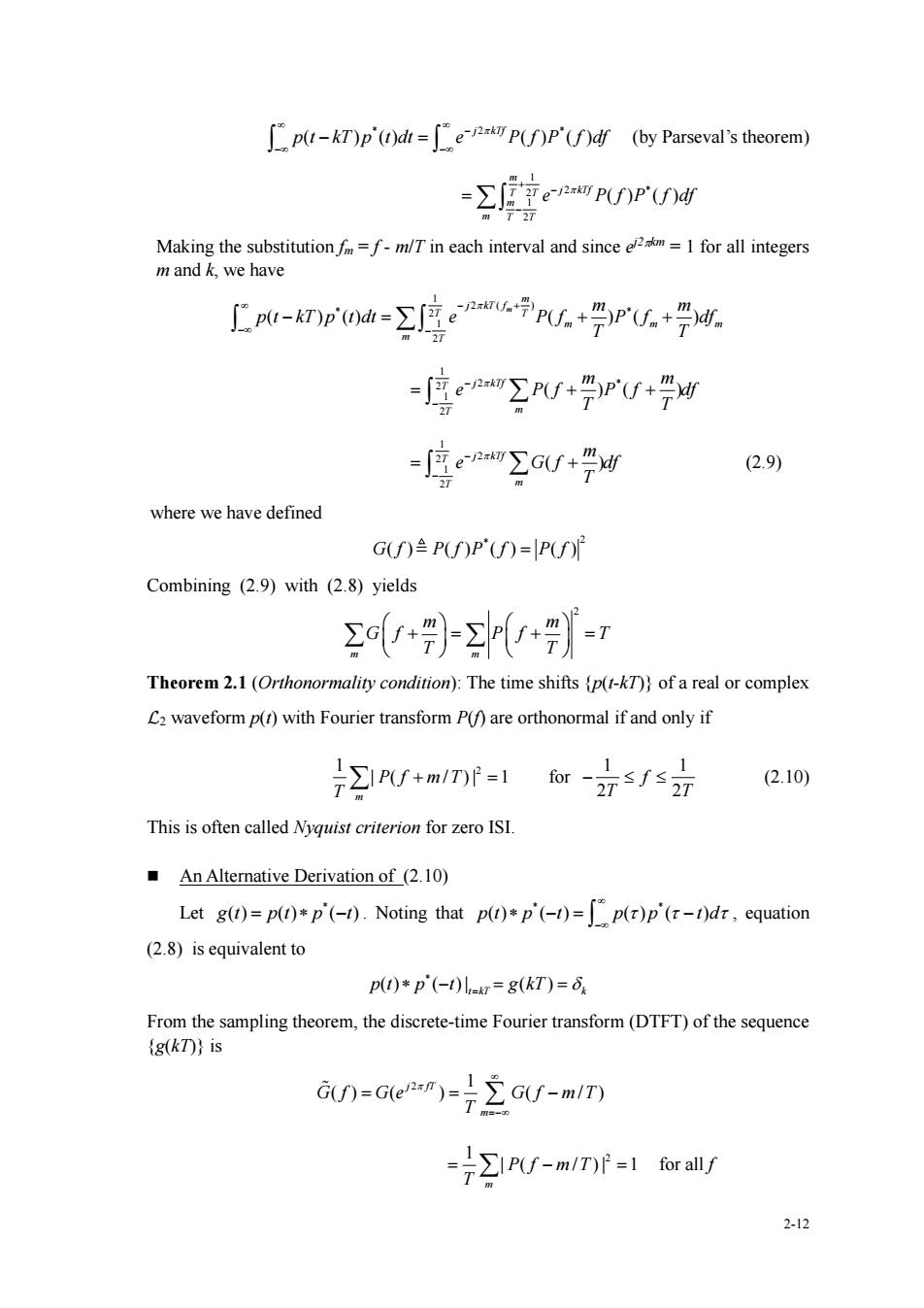正在加载图片...

[p(t-kT)p'(t)dt=[eP()P()df (by Parseval's theorem) =∑自P Making the substitution=f-m/T in each interval and since e2m=1 for all integers m and k we have L-切pah=度enc宁pU+学PrU,+學 =∫应e∑PU+"P'U+ =度ew∑cU+学 (2.9) where we have defined G(f)P()P'(f)=P( Combining (2.9)with (2.8)yields Σ+)-Σr+=7 Theorem 2.1(Orthonormality condition):The time shifts (p(-)of a real or complex C2 waveform p(r)with Fourier transform P()are orthonormal if and only if ∑PU+mf=1sfs7 (2.10) This is often called Nyquist criterion for zero ISI. An Alternative Derivation of(2.10) Let g(t)=p(t)*p'(1).Noting that p(t)*p(t)=p(r)p'(-1)dr,equation (2.8)isequivalent to p0*p'(-)L=g(kT)=6 From the sampling theorem,the discrete-time Fourier transform(DTFT)of the sequence g(D)is an=Gea)-号cU-mm =7∑iPU-m/T)f=1 forall 2-12 2-12 * 2 * ( ) ( ) ( ) ( ) j kTf p t kT p t dt e P f P f df − − − − = (by Parseval’s theorem) 1 2 2 * 1 2 ( ) ( ) m T T j kTf m m T T e P f P f df + − − = Making the substitution fm = f - m/T in each interval and since e j2km = 1 for all integers m and k, we have 1 2 ( ) * * 2 1 2 ( ) ( ) ( ) ( ) m m j kT f T T m m m m T m m p t kT p t dt e P f P f df T T − + − − − = + + 1 2 2 * 1 2 ( ) ( ) T j kTf T m m m e P f P f df T T − − = + + 1 2 2 1 2 ( ) T j kTf T m m e G f df T − − = + (2.9) where we have defined 2 * G f P f P f P f ( ) ( ) ( ) ( ) = Combining (2.9) with (2.8) yields 2 m m m m G f P f T T T + = + = Theorem 2.1 (Orthonormality condition): The time shifts {p(t-kT)} of a real or complex 2 waveform p(t) with Fourier transform P(f) are orthonormal if and only if 1 2 | ( / ) | 1 m P f m T T + = for 1 1 2 2 f T T − (2.10) This is often called Nyquist criterion for zero ISI. ◼ An Alternative Derivation of (2.10) Let * g t p t p t ( ) ( ) ( ) = − . Noting that * * p t p t p p t d ( ) ( ) ( ) ( ) − − = − , equation (2.8) is equivalent to * ( ) ( ) | ( ) t kT k p t p t g kT = − = = From the sampling theorem, the discrete-time Fourier transform (DTFT) of the sequence {g(kT)} is 2 1 ( ) ( ) ( / ) j fT m G f G e G f m T T =− = = − 1 2 | ( / ) | 1 m P f m T T = − = for all f